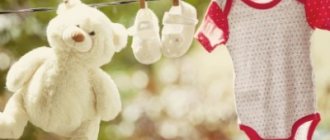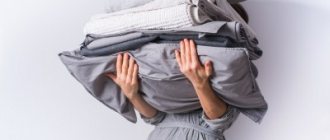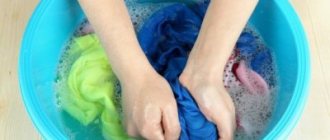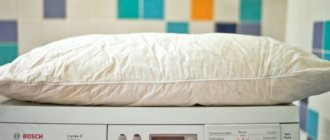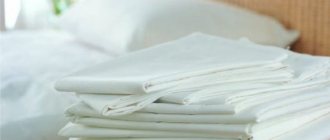At first glance, there is nothing complicated in washing bed linen, because most often it is made from fairly dense fabrics - calico, satin, silk, linen, and complex stains rarely appear on it. But there is another side to the coin: sheets, duvet covers and pillowcases are used intensively and washed often, so it is important to know a number of secrets that will help keep them attractive for a long time.
Modern bed linen is made from different types of fabrics
How to properly wash bed linen? The temperature and washing mode largely depend on the type of fabric from which it is made, but there are general rules that every housewife should know. Let's start with them.
Wash bedding in the washing machine following the instructions on the set label.
Washing frequency
Bed linen should be washed at least once every 7-10 days. During sleep, skin particles, germs, hair, sweat, and poorly washed off cosmetics remain on the pillowcase, sheet and duvet cover. If you do not properly care for your bedding, your pet’s “collection” will be replenished with microscopic insects, and fungi and bacteria will appear. In addition, the fabric gradually accumulates dirt and, if it is not washed for a long time, it will become gray and covered with stains, which will be very difficult to remove.
In some cases, the bed may need to be changed more often. For example, children, especially small ones (under 6 years old), need to be changed every 2-3 days. It is especially important for teenagers to change their pillowcase frequently - once every 1-2 days, since one of the causes of acne is clogging of the sebaceous glands with dust and dirt located on the surface of the pillow. Also, the bed is a favorable environment for the growth of bacteria that cause skin infections and diseases. If a person is sick, you need to wash your clothes every day or every 2 days to deprive germs of such an environment. If this is not possible, you should at least change your pillowcase daily.
The time of year also affects. In summer you need to wash your bed more often than in winter, since sweating increases in the warm season. The optimal interval between washes is 2-3 days.
Important! New linen must be washed before use. This will help remove the factory smell, as well as the impregnations that give the kit its “marketable appearance.”
Features for products made from different materials
Depending on the type of fabric from which the set is sewn, the rules for caring for it will differ . There are picky materials that are not afraid of even boiling, but there are also expensive bedding that requires a delicate attitude.
Cotton
This is the most popular material for sewing pillowcases and sheets. It absorbs moisture well and is not afraid of automatic washing. In extreme cases, cotton underwear can be boiled.
When washed in water exceeding 60-70 degrees, bedding may shrink.
You can use bleaching agents for washing . Spin at maximum speeds is allowed. Linen has similar properties.
Synthetics
Synthetic fibers are included in most bedding sets. However, for a comfortable sleep, sheets and pillowcases with a high content of them are not very suitable, since they do not allow moisture and air to pass through well.
Features of washing such products:
- water temperature – up to 40 degrees;
- spin at a speed no higher than 600 rpm;
- detergent without aggressive components in the composition.
The more intense the impact on synthetic fabrics, the faster they deteriorate.
Blended fabrics
Blended fabrics are a combination of natural and synthetic fibers. Their content in a particular bedding set will vary. Therefore, before you start washing, you need to read the manufacturer's recommendations.
Basic care tips:
- Hand and machine washable.
- Avoid using chlorine bleaches.
- The water temperature is not higher than 40 degrees.
- Spin at speeds up to 500 rpm.
With proper care, high-quality PBC made from mixed fabrics will last up to 5 years.
Satin
Satin linen is very pleasant to the touch, so sleeping on it is a pleasure.
Caring for it must meet the following requirements:
- colored satin is washed at 40 degrees;
- white satin is washed at 60 degrees - this is the maximum temperature;
- spinning can be carried out at maximum speed.
For satin, machine and hand wash are acceptable. Read more about the rules for washing satin bed linen here.
Bamboo
Bamboo bed linen can be washed by hand or machine. Caring for it does not present any difficulties.
Rules to follow:
- Do not exceed the water temperature of 40 degrees.
- Do not use aggressive detergents.
- Do not push at maximum speeds.
It is recommended to opt for the “delicate wash” mode.
Silk
Silk underwear is expensive and requires careful handling. That is why all machines have a separate item in the “silk” mode.
Washing is carried out taking into account the following features:
- water temperature – no higher than 30 degrees;
- detergents - only liquid;
- spinning is not allowed.
To prevent silk sheets from becoming electrified and shiny, it is recommended to use an antistatic agent for bed linen. It is included in most air conditioners (Laska, Ushasty Nyan, Synergetic, etc.).
Percale
Percale consists of cotton and other fabrics (polyester, linen or silk). The threads are woven quite tightly, which allows you to wash such bed linen in a machine.
Basic recommendations:
- The water temperature during the first wash is no higher than 30 degrees. In the future, percale can be washed at 60 degrees.
- Use of neutral liquid detergents, without bleaching components in the composition.
- Spin speed is up to 800 per minute.
With proper care, percale bedding can withstand more than 1,000 washes.
Jacquard
Jacquard bed linen looks attractive and is very pleasant to the touch. Such sets are rightfully considered a luxury item.
Basic care recommendations:
- Hand and machine washable;
- water temperature – no higher than 30 degrees;
- Spin is disabled.
You can iron jacquard linen only from the wrong side.
Velvet
Velvet bed linen is very demanding to care for. This is a delicate and noble material, which has been and remains a symbol of high status and high cost.
Basic cleaning recommendations:
- Hand wash only.
- Avoid granular powder, bleaches and conditioners.
- Prohibition on any type of spin.
Do not rub velvet with a brush. You can use a sponge to remove dirt.
Preparation
Before washing, laundry must be prepared. The sequence is as follows:
- Read the label carefully. Many people neglect the information on the label, some even throw it away because they consider it unnecessary. However, careful familiarization with the acceptable conditions for washing, ironing and drying can not only make the item visually attractive, but also save it.
- Sorting. Light and dark-colored items should be washed separately to avoid staining. Linen and calico should not be used together with silk. Synthetics should only be washed with synthetics, and natural fabrics with natural ones. In addition, children’s sets and linen should be washed after a sick person separately from others.
- Turning all pillowcases and duvet covers inside out. Check whether debris and dirt have accumulated in their corners; if there are zippers on the linen, fasten them.
- Pre-soaking heavily soiled items. You must first place the kit in warm water (50-60°C) with some detergent - laundry soap, powder or gel. It is preferable to wash dark fabrics with liquid detergents, as they do not leave streaks.
When is ironing required?
Ironing large items is extremely tiring. There are SMAs that provide easy ironing and anti-crease functions. After the automated processes carried out by CMA, ironing duvet covers manually seems like an unaffordable waste of time. Everyone decides for themselves whether to iron or not. We will just name the situations in which it is better to go over the bedding with a hot iron:
- If someone in the household is sick. Ironing is necessary to prevent the infection from being transmitted through the bed. It is recommended to provide the patient with separate supplies.
- Kits used for children up to one year old.
- With high humidity, in which things cannot dry completely.
Loading laundry into the machine
Load laundry into the washing machine according to its capacity. You should not try to fill the drum as much as possible; it is better to always leave a little free space - about 1/3 of the volume. So, washing, rinsing and spinning will be better. The permissible weight of loaded laundry is indicated on the machine itself or in the instructions. An average set of single bed linen weighs approximately 1.5 kg: about 400 g, two pillowcases, 300-400 g sheets and 500-700 g duvet cover. Therefore, a double set will weigh 2-2.5 kg depending on the weight of the material.
Selecting the mode temperature
What temperature is considered correct, effective and safe? Each fabric has its own properties and requires certain conditions for its care. Accordingly, each type needs to select its own temperature.
Got the right temperature? Amazing! This means that after washing you will receive the cleanest products without deteriorating their quality.
Advertising of powders promises a high-quality process even in cold water, but in reality the situation is different.
Let's consider what temperature for washing bed linen in a washing machine should be set for different situations and what result will be achieved:
- at 90 - 95°C linen, cotton, calico are completely washed and disinfected;
- at 60°C old stains are removed after pre-soaking;
- at 40°C they wash light and medium soiled items made from all types of fabrics, even terry;
- no more than 30°C - wash synthetic items, as well as jacquard and silk.
Colored sets are beautiful, but very capricious - they can fade. Therefore, do not take risks, set the temperature to no more than 40°C.
Important! Bed sets made of silk and satin do not boil!
Selecting temperature and mode depending on the type of fabric
All modern washing machines have basic and additional modes. Which one to choose depends on the type of fabric and degree of contamination.
The washing temperature depends on how dirty the laundry is. The more spots, the hotter the water. However, linens with patterns may fade when the temperature rises.
Cotton fabrics
Cotton and linen are the most unpretentious and affordable fabrics. We can say that a bed made of these materials is the most comfortable and practical, because it is beautiful, pleasant to the touch, practical and inexpensive.
Many modern models of automatic machines have a “Cotton” mode. We set the spin speed to 1200 rpm.
The temperature for washing cotton and linen fabrics without a pattern is 60°C, colored fabrics are 40-50°C. Heavily soiled bed linen can be washed at 90 degrees.
Cotton baby bedding should be washed at temperatures above 60°C to ensure it cleans better.
Linen and cotton dry quickly; they are not picky in this matter. However, you should not leave a set with a pattern in the sun, as it may fade.
Blended fabrics with added synthetics
You need to wash clothes made from fabrics with a combined composition carefully, since such materials are quite capricious, can shrink or become very deformed, and the pattern on such sets is erased quickly. Synthetics are not as convenient and healthy, but they are cheap, which is why they are popular. It is also resistant to aggressive influences and chemicals. There are several types of mixed fabrics:
- Polycotton is a mixture of polyester and cotton threads.
- Poplin is a combination of cotton and chemical fibers.
- Microfiber – 100% polyester.
- Percale is a mixture of 50% cotton and 50% polyester.
- Viscose is a cellulose-based fabric.
Washing clothes made from such materials should be done at low temperatures – no higher than 40°C. The “Synthetic” or “Delicate Wash” modes will provide the necessary care for synthetic sets.
Before washing bedding made from mixed fabrics, it is necessary to soak it. But you shouldn’t rub, because under the influence of external forces, pellets appear, which not only spoil the appearance, but are also unpleasant for the body.
Satin
Satin is a type of cotton fabric. This material has high density and strength, quality, and remains in good condition even after a couple of hundred washes.
You should not use bleach, especially when washing colored fabrics - this leads to fading of the design and rapid abrasion.
Satin bed linen should be washed at a temperature of no more than 40°C, and for heavily soiled items – at 60°C. You should use the “Delicate Wash” mode with a spin speed of less than 600.
Satin is a slightly wrinkled material, but it needs to be ironed to remove remaining germs and bacteria.
Attention! After washing, satin may shrink slightly, but manufacturers usually make bedding sets with this in mind.
Bamboo
Recently, bamboo beds have become especially common. The advantages of this material are that it is very soft, but durable, and has antibacterial properties that last for a long time.
If possible, wash bamboo clothes by hand at low temperatures. In this case, you should use gels that have a gentle effect.
Bamboo can also be washed in a machine, but at a temperature not exceeding 30°C, in the “Delicate Wash” mode. The spin must be set to minimum or even dispensed with.
Bamboo fabric should be dried on a horizontal surface so that it does not become deformed.
Silk
Silk is an expensive, luxury fabric. However, the properties justify the price: it is soft, durable, pleasant to the touch, and has a noble shine.
Silk bed linen must be washed at a temperature of 30°C, no higher. This is due to the fact that silk sheds quite a lot, and hot water will only speed up the process. You should select the “Delicate Wash” or “Hand Wash” mode. Spinning, twisting, rubbing and other manipulations with laundry can damage it. It is better to rinse the material in warm or cool water and dry it away from heating appliances. No soaking required. But you still need to iron the silk, but at a minimum temperature, without steaming.
Do I need to sort different clothes before washing them in a washing machine, what could be the consequences?
Often, dirty laundry is simply collected in the general wash, loaded into the machine and, having selected a mode, the process is started. At best, you might get lucky and nothing bad will happen.
But, in the end, such actions will lead to negative consequences, for example:
If you do not take into account the material from which the item is made and choose the wrong mode on the washing machine, then it may shrink.- Mistakes in choosing detergents for washing a particular type of clothing can ruin its appearance. For example, colored ones may lose their brightness, and white ones may fade or acquire a grayish tint.
- Washing white clothes together with colored ones, which tend to fade, can radically change the color of a light-colored item. The water will be colored and give a different shade to the white item. For example, if you wash it with red clothes, you may end up with a pink item.
- It is better not to combine items when washing that do not correspond to their intended purpose. For example, bed linen with sneakers and so on.
Choice of product
To ensure that your bed linen becomes clean after washing and does not lose its color and structure, you should know a few tips:
- For natural fabric, a powder that does not foam much is well suited.
- If the water in your area is hard, you should use a water softener. It will not only protect the machine from scale, but will also preserve the properties of the fabric. In this case, it is necessary to use more of the main product than when washing in soft water.
- It is worth washing things of people with allergies using liquid products rather than powders. The same applies to dark fabrics.
- There is no need to exceed the dosage of detergent; use exactly as much as indicated in the instructions.
- You cannot wash with expired products. The chemicals they contain become toxic to people, especially children.
Preparation - what to pay attention to
Bedding is made from several main types of fabric: linen, cotton, silk, satin, synthetics, bamboo, etc. Any material has unique properties that are important to preserve. For this:
- It is important to select a specific washing mode for each fabric. As a rule, the manufacturer provides washing recommendations - you can find them on a label attached to the product itself. The main thing is to understand the symbols.
- Sort things by type of material, color and degree of soiling. When washing synthetic fabrics together with natural ones, it is possible that “pillings” will appear on the cotton, and it also loses its softness. When mixing colored linen with white, part of the dye, no matter how persistent it is, will still transfer to white colors; Instead of a snow-white set, you can get things of a grayish tint.
- Before washing, turn things inside out, this way you can avoid the accumulation of particles of thread, feathers, etc. in the corners of the duvet cover or pillowcase.
- Before loading laundry into the machine, fasten any existing zippers, buttons, or Velcro.
- It is recommended to load the washing machine no more than 2/3 of its capacity.
- If there are stains or heavily soiled areas, soak the fabric in advance and add stain remover. Most machines have a soak or “pre-wash” setting. It is important to note that the function is not compatible with the quick wash program, and the duration of the process increases.
Before removing stains, you should make sure that the product you choose is safe for the fabric: to do this, you need to apply the product to some area of the fabric in an inconspicuous place from the inside out for 5-10 minutes. If the color and structure of the material have not changed, you can begin removing stains. By the way, information about the possibility of bleaching, in particular the use of chlorine-containing products, can be found on the label.
Does the new set need to be washed?
Many people ask this question and, after thinking about it, skip washing the set after purchase. And they are very mistaken, because the laundry needs to be cleaned of factory chemicals and the unpleasant odor removed. Most often, in factories, fabric is treated with a compound that helps it keep its shape. In addition, during the production process, dust and dirt, which are harmful to the human body, settle on the linen.
New bedding should be washed at the highest permissible temperature in order to disinfect it as thoroughly as possible. It will also remove excess paint, making the kit more attractive.
The fabric may shrink a little, but that’s not a big deal: the manufacturers have thought of everything.
Distribution by functional features
The final stage of sorting will be identification by functional features. Most of these rules are known to everyone, since they are quite logical, but it will not hurt to familiarize yourself with them:
Bad combination .
Shoes, such as sneakers, are always washed separately. Children's clothing is sent to a separate category. Curtains, curtains, blankets, blankets, jackets and down jackets - separately. Heavily soiled items and those that require light washing are also separated.- Good combination . Bed linen belongs to a separate category; it is permissible to add terry towels. Jeans - only with socks. The rest is selected according to shade, material, and total weight.
Features of washing baby clothes
Washing children's sets is a little different from usual.
Firstly, children are more active, so their bed quickly becomes dirty with crumbs, stains, and sweat. You can remove all this with laundry soap.
Secondly, children's things need to be disinfected more thoroughly. Therefore, it is recommended to wash in the “Baby” or “Delicate” mode at a temperature of 60°C or higher, if the type of fabric allows.
Thirdly, children are more prone to allergies, so it is better to use hypoallergenic gels; it is not recommended to take powders.
It is also worth remembering that children’s sets must be washed separately from adults, and oilcloths must be washed by hand.
How often should I wash?
The frequency of washing in each home is different. It is influenced by the intensity of use, the presence of children and pets in the house, personal preferences and views on cleanliness. Here are some useful tips:
- Throw your sheets and pillowcases in the wash at the first sign of loss of freshness. It is recommended to do this weekly. Duvet covers get dirty less, so you can run a gentle 30-degree program for them.
- If the frequency of water procedures is less than once a week, set the regime for a specific type of fabric and take into account the degree of contamination.
- You shouldn’t store a dirty set in a basket for a long time - while it lies there crumpled, dirt will eat into it intensely. It will be more difficult to wash such a set, and also to iron it.
How to wash faded clothes?
Unfortunately, many fabrics, especially bright ones, can fade a lot. To check whether a material has this property, you need to run a damp cloth over it and see if a colored mark remains on it.
To prevent things from shedding, you can soak them for 50-60 minutes in a solution of vinegar (1 tsp per 1 l), salt (1 tbsp per 1 l) or ammonia (5 drops per 1 l) in water . Afterwards, you need to thoroughly rinse the kit and put it into the automatic machine.
You can wash stained laundry using bleach for colored items (marked “Color”). In this case, the temperature should be set below 40°C.
Sort by color
There are certain guidelines on how to sort items by color, but the washing process will become much more difficult if you adhere to them unquestioningly. To simplify, you can use combinations with shades. Let's take a closer look at the general rules and possible combinations of things by color.
Which ones are allowed to be processed simultaneously?
You can wash items of the following colors and shades together:
Due to the peculiarities of the choice of powder and washing temperature, dark clothes should be washed separately from everyone else, but there are exceptions to the rule.
This category is diluted with clothing in dark colors: marsh, blue, brown, khaki, purple and similar shades.- The same rules apply to white things. It is allowed to wash clothes of light, pastel colors together. They also add light-colored items that contain a small color pattern or design.
- Separate rules apply for colored items.
Wash them using detergents for colored clothes. You can add light items with large-scale bright, colored designs or patterns. There is no need to separate sorting by color shades, but it is important to know that it is not recommended to add clothes that may fade to this category. You can take a risk and turn such a thing inside out. This will greatly increase the chance of not ruining other items, but it is best to wash it separately.
Which ones are not allowed?
It is not recommended to combine the following shades and colors:
- White and black .
These colors have completely different washing modes, in particular, temperature and choice of powder and conditioner. When washing light colors, bleach or strong detergents are often used; in this case, black clothes may lose their original color. Dark laundry is washed at low temperatures, which will negatively affect the quality of white laundry. Well, the last thing worth noting is that dark things that tend to fade will give light-colored linen a grayish tint. - Colored and white . Low temperatures will reduce the effectiveness of washing whites. For each of these categories, special powders are used. Therefore, combining will not bring the desired results, but will only reduce the overall quality of the washing process.
- Colored and black . Although these categories have common temperature indicators, they have features related to the choice of chemicals. Therefore, it is not recommended to combine them. With the exception of shades that are as close as possible to black.
How to wash heavily soiled laundry?
It happens that over time the bed becomes gray or yellow, stains appear on it that are almost impossible to remove.
There are products that help wash washed bed linen, for example, Domestos and Belizna bleaches. It is necessary to soak the bedding set in water using the selected product in accordance with the instructions indicated on the package.
There are also traditional methods of dealing with yellowness and spots:
- Ammonia. A few drops should be added to very warm water when soaking. After half an hour, gently wring out the fabric and put it in the washing machine.
- Boric acid. 2 tbsp. l. must be dissolved in 3 liters of water. Soak for 40-50 minutes, then wash.
- Hydrogen peroxide. 1 tbsp. need to be diluted in 3 liters of water, left for 30-40 minutes.
- Yellow stains can be washed off with laundry soap or Antipyatin. First, you should gently rub the dirt with it, then soak the item in a soapy solution for 3-4 hours.
How to properly wash by hand?
You can wash your bed linen by hand. This requires some effort, but this method of processing is considered more gentle. Hand washing is especially important for caring for delicate fabrics.
Step-by-step algorithm of actions:
- Fill a large basin or bathtub with warm water.
- Dissolve detergent in it. You need to choose either a universal liquid composition or a powder intended for hand washing. The packaging of detergent should have an icon in the form of a basin with a hand placed in it.
Soak bedding in water.
The time it is kept in the washing solution depends on the degree of contamination of the fabric. General recommendations: for white items – 1-3 hours, for colored fabrics – no more than 60 minutes.- Remove difficult stains. If the material allows, you can use a brush with soft bristles.
- Using gentle squeezing movements, stretch the entire surface of sheets, pillowcases and duvet covers step by step.
- Rinse things in warm water. To make them soft, you can add fabric softener.
- Wring things out and send them to dry.
It is necessary to rinse the laundry until the water stops foaming, since the detergent particles remaining in the fabric fibers will slowly destroy them. In addition, with constant contact with the skin, they can provoke the development of allergies.
What to do if the bed smells unpleasant after washing?
An unpleasant smell from clothes after washing can appear for several reasons:
- Irregular ventilation of the drum.
- Using the wrong powder.
- Excessive use of cleaning solutions.
- Leaving dirty or wet clothes in the drum for a long time.
- Lack of proper care of the washing machine.
- Incorrect connection of the hose to the sewer.
You can combat this in the following ways:
- Troubleshooting automatic machine operation. To do this, it is better to call qualified craftsmen; you should not carry out repairs yourself, as this can only worsen the situation.
- If there is mold on the drum, you should treat it with a solution of copper sulfate and leave it for a day.
- You can wash your laundry from the “aroma” of dampness using 150 g of citric acid and 100 g of soda poured into the machine. To do this, you need to set the longest mode and temperature to 90°C.
- A small amount of vinegar also works great for removing musty odors.
Removing difficult stains
To combat difficult stains, it is not necessary to use aggressive detergents. Available and inexpensive substances that everyone has in their home come to the rescue:
Blood. It can be removed using hydrogen peroxide, which is applied to a cotton pad and wiped with it until the stain disappears completely.- Urine, sweat and other secretions .
Baking soda and vinegar work well with such stains. They are applied one by one to the fabric, wait until the foaming reaction ends, leave for 30 minutes and wash as usual. - Oily spots . They can be easily removed using a mixture of salt and starch. The powder is applied to the stain, left for an hour, and then washed.
- Cosmetics stains . The most accessible means for removing them is laundry soap. It is grated, diluted with water and applied to the stain as a paste. After 30 minutes the item needs to be washed.
- Wine, coffee, tea . You can neutralize the coloring pigment with ammonia. It is applied to a cotton pad, which is used to wipe the stain until it disappears completely.
Drying
Recommendations for drying bed linen:
- Products should be hung in such a way that they are as straight as possible;
- the room must be well ventilated;
- Do not dry the bed on heating devices or near sources of open fire;
- It is not recommended to dry the bed in the sun, as ultraviolet radiation contributes to the destruction of fabric fibers.
Delicate materials, such as silk, velvet or jacquard, should be dried on a flat, horizontal surface.
